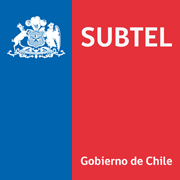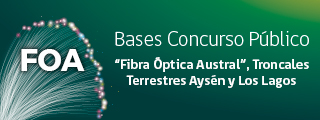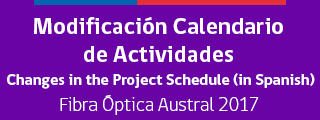Preguntas Frecuentes / Frequent questions
| Preguntas Frecuentes | Frequent questions |
Preguntas frecuentes sobre la nueva licitación
El objetivo principal del Proyecto de Fibra Óptica Austral es desarrollar una infraestructura de telecomunicaciones de alta capacidad de acceso abierto, no discriminatoria para el sur de Chile. Cuando se complete, se convertirá en el nodo más meridional del mundo de la infraestructura global de cable óptico. Después de un primer intento en 2016, el Gobierno de Chile a través de SUBTEL está listo para lanzar un nuevo llamado a licitación. Hay cambios importantes por delante. Las siguientes son algunas de las preguntas comunes sobre el nuevo proceso de licitación.
Nota: El presente documento es un material de apoyo para quienes tengan interés en participar en el Concurso Público del Proyecto “Fibra Óptica Austral”. El instrumento y texto oficial es aquel que constará en el respectivo acto administrativo totalmente tramitado que apruebe las Bases de Concurso.
1. Cronología del proyecto: ¿Cuándo se planea llamar a la nueva licitación?
Se espera llamar a concurso durante el mes de Abril del presente año. La fecha definitiva será anunciada públicamente a la brevedad. En cuanto a la presentación de las Propuestas por parte de las empresas se difiere según el tipo de Troncal:
– Para la Troncal Submarina, las empresas interesadas deberán presentar sus propuestas el mes de Junio del presente año.
– Para las Troncales Terrestres, las empresas interesadas deberán presentar sus propuestas el mes de Julio del presente año.
2. Presupuesto para el Proyecto: ¿Es el mismo que para la licitación de 2016?
El presupuesto general para el Proyecto Fibra Óptica Austral es un subsidio del Gobierno de Chile por un monto aproximado a US $100 millones ($64.148 mil millones de pesos chilenos)
3. ¿El ganador ofrecerá el servicio sólo en Chile o también podrá cubrir cualquier tráfico internacional?
Las bases del concurso establecen que el servicio debe entregarse en las regiones en donde se implementará proyecto. Sin perjuicio de lo anterior, la infraestructura instalada a raíz del proyecto, puede ampliarse para la prestación de servicios de telecomunicaciones a otras regiones del país, como también a otros países cercanos a los sectores beneficiados por el Proyecto Fibra Óptica Austral, siempre y cuando cumplan con la normativa vigente de cada país.
4. ¿El modelo de negocio es el mismo que el de la licitación de 2016? (Presupuesto para la ejecución CAPEX y operación cubierta por la tarifa de operación)
Técnicamente, se mantiene el modelo de negocio de la primera licitación, además de la obligación de la empresa o consorcio que se adjudique el proyecto de instalar, operar y explotar toda la infraestructura que se construya. Con respecto a la comercialización, la proponente deberá proponer las tarifas máximas a cobrar por los servicios exigidos.
5. Criterios de evaluación de ofertas: ¿Será igual que el plan de 2016, con tarifa más baja para la red?
El criterio de evaluación contempla, entre otros elementos, otorgar puntaje a la tarifa más baja ofrecida para el arriendo de un canal óptico. Los postulantes con mejores puntajes y con propuestas técnicas que cumplan las exigencias del concurso, serán seleccionados para una siguiente etapa, en donde la empresa que solicite el menor subsidio será la ganadora del concurso.
6. Requerimiento tecnológico o rutas específicas: ¿La nueva licitación mantiene el mismo diseño de OIPTI?
Las nuevas bases del concurso introducirán algunas modificaciones tanto a los requerimientos técnicos como a los criterios en la definición de las rutas seleccionadas por las proponentes. Con respecto al diseño de los OIPTI, se mantienen sus requerimientos pero la instalación de los elementos, equipos y componentes deberá implementarse de acuerdo de la demanda de los servicios exigidos.
7. Si la implementación se extiende a 26 meses, ¿cuál serán los hitos más importantes?
Las empresas adjudicatarias contarán con los siguientes plazos máximos de implementación, contados desde la total tramitación de la concesión entregada por el Concurso Publico:
– Inicio de las obras: 12 meses.
– Término de las obras: 24 meses.
– Inicio de Servicio e Infraestructura: 26 meses.
8. ¿Habrá 4 proyectos diferentes y es posible solicitar una entrada o más de una entrada? (3 terrestres y 1 SUBMARINA)
Las empresas pueden postular tanto a la troncal submarina como a las troncales terrestres o cualquier combinación de ellas.
9. ¿El participante debe estar constituido en Chile más de dos años al igual que para la licitación de 2016?
Las empresas que presenten propuestas a esta licitación deberán, al momento de la presentación de su postulación, ser una persona jurídica, de derecho público o privado, constituida en Chile y con domicilio en el país. Adicionalmente, esta empresa deberá presentar los balances generales y estados de resultado de los últimos dos ejercicios contables.
En el caso que esta empresa no los tenga, por no tener una antigüedad en Chile igual o superior a 2 ejercicios contables, se propiciará que la empresa presente los balances generales y estados de resultado de los últimos dos ejercicios contables de sus matrices, sean nacionales o extranjeras. Esta posibilidad, aún debe someterse al control preventivo de legalidad de la Controlaría General de la República.
Para la postulación a través de Consorcio opera la misma figura, respecto de todas las empresas que lo compondrán.
10. La región geográfica que cubre la nueva licitación: ¿se reduce, es la misma, o se incluyen algunos cambios en las rutas?
La nueva versión de las Bases de Concurso no contemplan cambios respecto del área geográfica a beneficiar, sin perjuicio de que fueron introducidas algunas modificaciones asociadas a las localidades consideradas en cada Troncal y a la obligación de la instalación de POIIT en ellas. Una de las modificaciones, contempla la exigencia de 4 POIIT en vez de 6 POIIT para la Troncal Submarina Austral. Lo anterior, se detallaran una vez estén publicadas las Bases de Concurso.
Frequently asked questions on the new Request for Tender
The Southern Optical Fiber Project’s main goal is to deploy an open-access, and nondiscriminatory high capacity telecommunications infrastructure for the south of Chile. When completed, it will become the world’s southernmost node of the global infrastructure of optical cable. After a first attempt in 2016, the Government of Chile through SUBTEL is ready to launch a new Request for Tender. There are important changes ahead. The following are some of the common questions about the new bidding process.
Note: This document is a support material for reference of those interested in participating in the Tender for the Southern Optical Fiber Project’s. The official content and specific details of the Request for Tender will be published when the respective administrative act is fully processed and approved.
1. Timeline for the project: When is the bid planned?
SUBTEL expects to call for tenders during April of 2017.
The final date will be publicly announced as soon as possible.
As far as the presentation of the Proposals by the companies, differs according to the type of Trunk:
– For the Submarine Trunk, interested companies should present their proposals in June of this year.
– For the Terrestrial Trunks, interested companies should present their proposals in July of this year.
2. Total budget for the project: Is it the same as the 2016 plan?
The general budget for the Southern Optical Fiber Project is a subsidy from the Government of Chile for an approximate amount of US $ 100 million (CLP $ 64,148 billion)
3. Will the winner be servicing only in Chile or will it also cover any international traffic?
The bidding rules state that the service must be provided in the regions where the project will be implemented. Notwithstanding the foregoing, the infrastructure installed as a result of the project may be extended for the provision of telecommunications services to other regions of the country, as well as other countries close to the sectors benefited by the Southern Fiber Optic Project, provided that comply with the current regulations of each country. It should be noted that such expansions should be financed by the awarded bidder.
4. Budget for implementation CAPEX and operation covered by the operation tariff: Is the business model the same as the 2016 plan?
From a technical point of view, the new tender maintains the same business model of the first tender, besides the obligation of the awarded company or consortium to install, operate and exploit the telecommunications infrastructure deployed. Regarding the commercialization of the required services, the bidder should propose the maximum rate to be charged for those services.
5. Bid evaluation criteria: Is it the same as 2016?
The bid evaluation criterion contemplate, among other things, awarding the lowest rate offered for the lease of an optical channel. The applicants with the best scores and technical proposals that meet the requirements of the contest will be selected for a next stage, where the company that requests the lowest subsidy will be the winner of the contest.
6. Technology requirement or specific routes: Is it designing the same OIPTI?
The new bidding rules introduce some modifications to both the technical requirements and the criterion to be used for the definition of the routes to be considered in the installation of the optical cable. Regarding the design of the OIPTI, it should be noted that the requirements are the same, notwithstanding of the fact that the installation of equipment, components and elements necessary for the provision of the required services should be implemented in ac-cordance with the demand for those services.
7. If the implementation is extended to 26 months, what would be the main mile-stones?
The awarded companies will have the following maximum implementation deadlines, counted from the end of the processing of the license awarded by the tender:
– Beginning of construction: 12 months.
– End of construction: 24 months.
– Beginning of and Infrastructure Service: 26 months.
8. Will there be 4 different projects and is it possible to apply for one entry, or more than one entry (3 terrestrials and 1 sea)?
The tender considers the deployment of four projects, and companies can offer both the submarine trunk and the terrestrial trunks or any combination of them.
9. Should the participant be in Chile for more than two years as in the 2016 bid?
The participants (companies submitting bids to this tender) must, before submitting their offer to SUBTEL, be a legal person, whether public or private, constituted in Chile and dom-iciled in the country. In addition, these companies must present the balance sheets and in-come statements for the last two accounting years.
In the event that a company does not have the financial reports mentioned above for not hav-ing a seniority in Chile equal to or greater than two accounting periods, this company will be able to present the balance sheets and income statements of the last two accounting periods of their parent company, whether national or foreign. This possibility shall be subject to the preventive control of legality of the General Comptroller of the Republic of Chile.
For the application through Consortium: the same rules operate with respect to all companies that will be part of the Consortium.
10. The geographic region that covers the new tender: is it reduced, is it the same, or are some changes included in the routes?
The new version of the Tender does not contemplate changes regarding the geographic area to benefit, notwithstanding that some modifications associated to the localities considered in each Trunk and the obligation of the installation of OIPTI in them were introduced. For instance, one of the modifications contemplates the requirement of 4 OIPTI instead of 6 OIPTI for the Submarine Trunk. The above, will be detailed once the Call for Tender is officially published.






